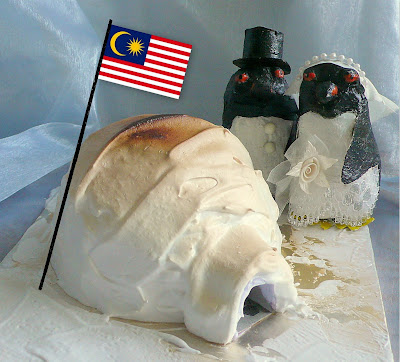 |
| ORANGE BLOSSOM |
Being a sucker for pretty cake pans, I got a six-cup Silicone rose cake mould the last time I was at the baking supply shop. This one seems a bit flimsy for the oven, unlike another Silicone mould I have which is firm and doesn't need to be supported by a baking sheet. But what the hey, let's give it a try.
As you can see from the picture, there was nothing wrong with the pan.
This cake uses the principle of a 1-2-3-4 cake: 1 cup butter, 2 cups flour, 3 cups sugar and 4 eggs – basically, the same weight of all the main ingredients. (This
LA Times article explains it; with recipes.) The recipe lends itself well to variations and here flour is substituted with almond meal (ground almonds), one less egg is used and orange juice is added.
The original recipe lists the quantities in pounds, ounces and pints. I've done metric conversions and rounded up the numbers because 57g or 94ml seems random. This recipe is quite forgiving and as long as all the figures are consistent, it should be all right. (I include Julia Child's original numbers in brackets, just in case.)
Oh, and don't be foolish (like someone
;-p) and think that a Silicone mould doesn't heat up in the oven. Try grabbing it with a bare hand and you may not have fingerprints left!
GÂTEAU À L'ORANGE ET AUX AMANDES
(Orange and Almond Spongecake)
Adapted from
Mastering the Art of French Cooking by Julia Child
et al. Mrs Child made this cake in a round tin 9 inches (22cm) in diameter and 1½ inches (4cm) high. I used six silicone ½-cup cake moulds in the shape of roses and two small ramekins.
Serves 8
120g (¼ pound) butter, melted
120g (4 oz) granulated sugar (or caster sugar)
3 egg yolks
Grated rind of 1 orange
100ml (⅛ pt) strained orange juice
¼ tsp almond extract (only if you like the taste; can be left out or substituted with vanilla extract)
120g (4 oz) ground almonds
60g (2 oz) sifted cake flour (or plain flour)
- Butter and flour eight ½-cup cake moulds. Preheat oven to 180°C.
- Gradually beat the sugar with the egg yolks and continue beating until the mixture is thick, pale yellow and forms a ribbon. Add the grated orange rind, orange juice and almond extract. Beat for a moment or two until mixture is light and foamy. Then beat in the almonds and finally the flour.
3 egg whites
Pinch of salt
1 tablespoon caster sugar
- Beat the egg whites and salt together in a separate bowl until soft peaks are formed; sprinkle on the sugar and beat until stiff peaks are formed.
* * *
- Using a rubber spatula, fold the cool melted butter into the cake mixture, omitting milky white residue at bottom of butter pan. Stir ¼ of the egg whites into the mixture; delicately fold in the rest.
- Immediately turn into prepared moulds and run the mixture up to the rim all around. Bake in the middle of the preheated oven for 22-25 minutes for the mini cakes (of you use a large cake tin, give the cake 30-35 minutes). The cakes are done when they have puffed, browned lightly, tops are springy when pressed and a needle (skewer or toothpick) plunged into the centre comes out clean.
- Remove to a cake rack and allow to stand 10 minutes, until cakes begin to shrink from sides of moulds. Remove and cool completely on the rack.
- Serve dusted with icing sugar.
PRINTABLE RECIPE





